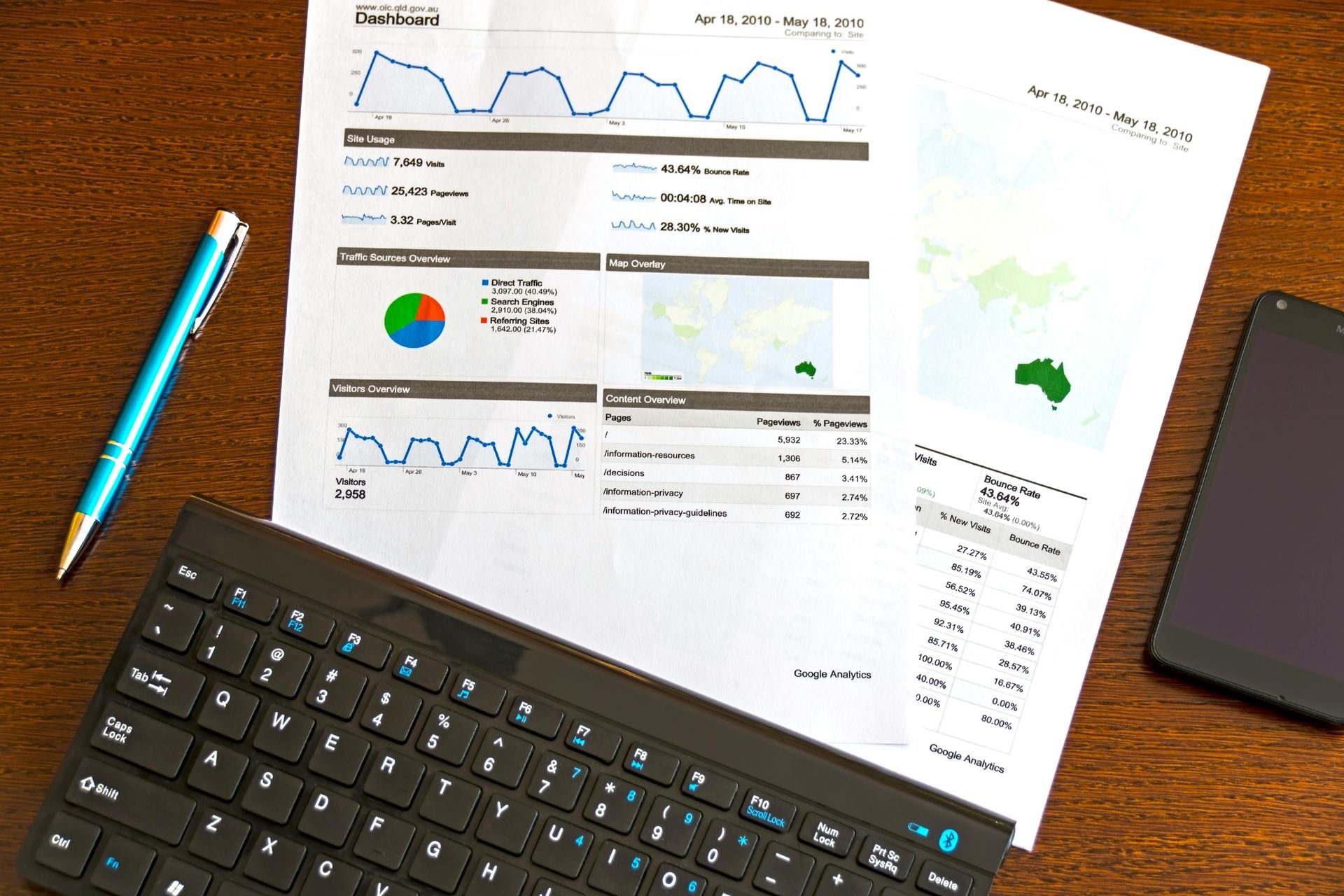Business today moves too fast to run on gut feel. Customers expect relevance, leaders expect clarity, and teams are being asked to hit targets with less margin for trial and error. The companies that are consistently winning are not guessing their way forward. They are measuring, interpreting, and acting. That is the promise of business analytics and web analytics working together. Business analytics looks across the organization and asks what is really happening inside revenue, operations, product, finance, talent, and retention. Web analytics looks at how people actually behave in digital environments — how they arrive, what they engage with, where they drop off, and what finally gets them to act. When you connect those two layers, you get something powerful: a live, evidence-based model of how value is created (or lost) in your business.
At its core, analytics is about using data to make better decisions. It is the process of collecting information, structuring it, analyzing it, and interpreting it in a way that reveals patterns, problems, and opportunities you would not see otherwise. That could mean spotting a decline in conversion before it becomes a revenue problem. It could mean seeing that a particular channel is driving traffic but not qualified buyers. It could mean identifying which internal process is slowing every deal by five days for no good reason. It could mean forecasting demand before inventory is committed. Rather than reacting once things are already broken, analytics lets you intervene earlier, with more confidence, and with a clearer sense of what to change.
The reason this matters now is access. A decade ago, this level of insight was mostly reserved for large enterprises with data teams, licensed software, on-prem systems, and long reporting cycles. Today, almost any organization — startup, agency, clinic, eCommerce brand, nonprofit, regional retailer, SaaS company, services firm — can collect, visualize, and act on meaningful performance data without building a full data department first. Cloud analytics tools, self-serve dashboards, web tracking platforms, open-source statistical tooling, and AI-assisted modeling have brought serious capability within reach. The shift is cultural as much as technical. Leaders are starting to expect proof. Teams are expected to explain not just what they’re doing, but why it’s working. Analytics is how you answer that without turning every conversation into opinion versus opinion.
The Three Core Modes of Analytics
Every useful analytics practice tends to move in three modes: descriptive, predictive, and prescriptive. These modes are not buzzwords. They are different kinds of questions.
Descriptive analytics answers the question “what happened.” It looks backward at real performance and creates a reliable view of reality. This is where dashboards, performance summaries, traffic and engagement reports, revenue snapshots, lead volume breakdowns, funnel conversion rates, and cost reports live. Descriptive analytics is incredibly important because most organizations are not suffering from a lack of data. They’re suffering from a lack of clean, agreed-upon visibility. Sales says one thing. Marketing says another. Finance has a third number. Without a shared version of the truth, the team burns time arguing about the baseline instead of deciding what to do. Descriptive analytics removes that friction by saying, here is what actually happened, here is how it trended over time, and here is where the line started to bend.
Predictive analytics answers the question “what is likely to happen next.” Instead of stopping at past performance, predictive models take historical data, identify patterns, and use those patterns to forecast outcomes. This is where demand forecasting, revenue forecasting, churn risk scoring, sales velocity projections, inventory planning, usage projections, and lead scoring come from. The value here is not magic or fortune telling. It’s risk reduction. If you can see, with reasonable confidence, that a channel is tapering off, that a segment of customers is starting to disengage, that inventory for a product line is going to dip below safe levels next quarter, or that a certain type of lead almost never converts unless nurtured a specific way, you can act before the problem becomes expensive. Predictive analytics moves the organization from reactive to proactive.
Prescriptive analytics answers the question “what should we do about it.” This is where analytics moves from insight to recommendation. Instead of just telling you that a certain kind of customer is at risk of churning, prescriptive logic can surface the specific next best action to retain them — escalate to success, deploy an offer, surface education, trigger outreach. Instead of just flagging that a campaign is overspending without return, prescriptive views can recommend shifting budget to the channel that is showing stronger cost per qualified lead. Instead of just warning that production capacity will bottleneck in six weeks, it can lay out the most efficient staffing or scheduling adjustment to prevent that bottleneck. Prescriptive analytics respects your constraints. It says, given our cost limits, people limits, compliance limits, and timing limits, here is the best move available right now.
Together, these three modes create a loop. Descriptive tells you what happened. Predictive tells you what’s likely to happen. Prescriptive tells you how to respond. Mature teams operate in that full loop. Early-stage teams often start with descriptive, build trust in the numbers, and then grow into predictive and prescriptive as they get more confident. The important thing is not how advanced the math is. The important thing is whether the output informs real decisions that change behavior.
Where Analytics Actually Drives the Business
The impact of analytics is not limited to a single department. It touches almost every meaningful function because every meaningful function is making decisions under uncertainty.
In marketing, analytics shows you who is engaging, how they found you, which messages resonate, and which offers actually convert. It becomes possible to segment audiences by behavior instead of guesswork, personalize campaigns that match what people actually care about, and stop spending against channels that generate noise instead of pipeline. Web analytics, specifically, becomes essential here. Watching how visitors move through your site — which pages they land on, how long they stay, where they bounce, which calls to action they ignore, which ones they click — gives you an unfiltered record of buyer behavior. That record is more honest than survey answers. It shows what people do, not just what they say they do.
In sales and revenue operations, analytics clarifies pipeline health. You can see which lead sources tend to generate serious conversations, which reps move deals fastest and why, how long each stage typically takes, where deals stall, and which objections show up most often before a deal dies. That level of clarity turns forecasting into something more concrete. Instead of “we think we can close this much this quarter,” you can say “based on current stage distribution and historical win rates by segment, here’s what’s likely to land, here’s what’s at risk, and here are the three moves most likely to change that outcome.” Sales leadership gains visibility. RevOps gains influence. Finance gains confidence.
In finance, analytics becomes a control surface for the whole business. You begin to see the actual cost of acquiring customers in different segments, the real margin per product line, the churn risk by cohort, the burn rate trend given current hiring plans, and the impact of pricing experiments on both volume and profitability. This is where analytics earns its seat in strategic planning. You are no longer steering from the rearview mirror. You have early warnings, forward projections, and scenario modeling you can actually defend.
In operations, analytics shows you where the machine is slowing down. You can observe response times, handoff delays, production throughput, inventory turns, support load, and recurring failure points. When you can see which process steps consistently create drag, you can redesign them or automate them. When you can see which vendors or locations or shifts tend to fail, you can intervene with precision instead of issuing vague “we need to do better” mandates that frustrate everyone and fix nothing. In supply chain, in logistics, in scheduling, in fulfillment, in service delivery, analytics replaces guesswork with traceable bottlenecks and measurable improvements.
In product and customer experience, analytics shows what users actually do once they are in. You can see which features drive adoption, which steps cause abandonment, which content deflects support tickets, which actions correlate to long-term retention, and which onboarding paths quietly push people away. Connecting this product usage data to web analytics and commercial data completes the picture: where did they come from, what convinced them to try, what did they do once they got access, and did that behavior lead to value fast enough for them to stay. That loop is how you improve onboarding, reduce churn, and build features that matter instead of features that simply sound impressive.
Even in people operations and HR, analytics is shaping decisions. Headcount planning, retention risk, ramp time for new hires, productivity patterns, skill gaps, burnout indicators, and internal mobility paths all show up in the data. When leadership can see those signals early, staffing stops being purely reactive. You are not waiting until a team is underwater to realize they need help. You have enough lead time to recruit, reorganize, or rebalance.
The throughline is this: any function that makes recurring, high-impact decisions benefits from analytics. If a team is deciding where to spend money, where to spend time, where to put people, or what to do next, that team is a candidate for analytics. It is not limited to marketing dashboards and traffic charts anymore. It is operational.
When to Use Analytics (and Why It’s Not “Someday” Work)
Organizations sometimes talk about analytics like it is something they will “get to later” once they are bigger, calmer, or more resourced. That is a mistake. The most urgent moment to lean on analytics is usually the moment where things feel most chaotic, because that is when bad decisions multiply the fastest.
Analytics should be used when there is more data than you can manually reason about. If you are getting enough leads, enough traffic, enough support tickets, enough product interactions, or enough transactions that you cannot track it all by hand, you are already past the point where spreadsheets and hallway conversations are enough. At that stage, relying on instinct becomes expensive. You could be optimizing the wrong step in the funnel, scaling the wrong campaign, hiring into the wrong function, or letting revenue leak in a way you truly cannot see yet.
Analytics should also be used when something feels off but you cannot explain why. A dip in conversion, an increase in cancellations, a slowdown in sales velocity, a drop in engagement, a spike in escalations — these are symptoms. Without analytics, you are stuck guessing at causes and throwing fixes at the wall. With analytics, you can isolate where the break actually happened. Maybe it is not that demand is down. Maybe it is that one stage in the handoff between marketing and sales is suddenly lagging by forty-eight hours because of internal bandwidth. Maybe it is not that a product got “worse.” Maybe it is that one onboarding step was changed and is now confusing people who used to activate smoothly. Finding the real cause quickly lets you apply the right correction instead of burning weeks on the wrong theory.
Analytics is also essential any time you are about to scale. Scale makes inefficiency louder. If you are generating five leads a day and you drop one, that’s annoying. If you are generating five hundred leads a day and you are still dropping twenty percent of them because routing is broken, that is a disaster. If you are closing a handful of deals a month and your forecasting is off, leadership can live with it. If you are committing to investors, partners, procurement timelines, vendor relationships, or staffing plans based on inaccurate forecasts, that becomes real risk. Scaling without analytics is like accelerating with the dashboard covered. You might be fine. Or you might hit a wall at full speed and not know why.
And then there is accountability. Analytics is what allows you to walk into a board meeting, an investor update, a leadership review, or an internal planning call and speak in terms of signal instead of spin. You can show what happened, what you expect next, and what you are doing about it. That clarity builds trust. Internally, it reduces politics because decisions are tied to shared truths, not personalities. Externally, it demonstrates control, which is something every serious partner, buyer, or investor looks for.
Tools, Teams, and Turning Insight Into Workflow
One of the biggest misconceptions around analytics is that you need to start with heavy infrastructure and a specialized team. The reality is that most organizations can begin building useful visibility with tools they already have access to. A website analytics platform can show traffic sources, behavior flows, and conversion funnels. A CRM can show lead quality by source, stage progression, and win rates. A project or ticketing system can show response time, backlog growth, and resolution patterns. A finance tool can show revenue trends and cost centers. A simple reporting layer can centralize those views into something leaders can actually use.
From there, more advanced tooling adds power. Visualization platforms make complex data easier to interpret at a glance. Statistical languages like Python and R let you build forecasts, segment audiences, detect anomalies, and run more serious experimentation when you are ready. Machine learning models can start to identify trends too subtle for a human to notice at scale, like the combination of behaviors that most reliably predict churn, or the sequence of steps in a sales motion that tends to win at higher average contract value. But those layers are accelerators. The foundation is still clean inputs, consistent definitions, and an agreed-upon source of truth.
Who uses these tools is also changing. Once, analytics was “for the data team.” Everyone else submitted requests and waited. That model is too slow for how most teams need to operate now. Marketing leads are expected to defend spend without a dedicated analyst standing next to them. Sales and RevOps teams are expected to forecast and prioritize with clarity. Product managers are expected to build roadmaps anchored in real usage. Operations leaders are expected to justify headcount and process changes. Finance is expected to model scenarios quickly, not just report last quarter. This means analytics has become part of the job for almost every function. The skill is no longer “can you read a dashboard,” it’s “can you interpret what this means for our next move.”
That said, ownership still matters. Someone in the organization needs to be responsible for data hygiene, access, consistency of definitions, security, and governance. Without that, you end up with five dashboards all claiming to be “the real one,” and no one trusts any of them. The healthiest setups treat analytics like an internal product. It has stakeholders, a roadmap, a point of contact, and standards. It evolves. It gets supported. It is not just a one-time report pack that slowly goes stale.
Why Analytics Is More Accessible Than Ever
For a long time, analytics was locked behind high cost and high expertise. That is no longer true, and that shift is one of the biggest reasons even smaller teams can and should lean into data-driven decisions.
Cloud-based platforms have removed the need for heavy infrastructure. Instead of standing up servers and buying enterprise licenses before you can even start, you can plug in, authenticate, and begin collecting and visualizing data in hours. That alone has changed the adoption curve for early and mid-stage companies. You do not have to wait until “someday.” You can stand up credible reporting now.
Self-service analytics has changed who can participate. Non-technical team members can explore dashboards, filter views, build simple reports, and answer first-layer questions on their own. They don’t have to file a ticket for every “can you pull me X.” That speed matters because it keeps curiosity alive. When the cost of getting an answer is low, people ask better questions and make better decisions sooner.
Open-source tools have made advanced analysis possible without licensing cost. Languages like Python and R, along with their ecosystems of libraries, give even lean teams the ability to run predictive models, segment behavior, test hypotheses, and visualize outcomes with a level of sophistication that used to require specialized vendor contracts. This isn’t just about saving money. It’s about flexibility. You are not locked into a black box you can’t extend or audit.
Interfaces have become more human. Dashboards are cleaner. Funnel builders are visual. Event tracking is more guided. Attribution models are more transparent. Teams can talk about data without needing to translate everything through jargon. That reduces intimidation and speeds up adoption.
Education has become widely available. Teams don’t have to guess or wait for one expensive workshop. There are resources, walkthroughs, playbooks, and training programs everywhere. Analytics literacy is turning into a baseline expectation in many roles, the same way basic digital literacy became non-negotiable years ago. The idea that “data people” sit over here and “business people” sit over there is fading. The walls are thinner.
All of this adds up to a simple reality. Being data-driven is not a future-state maturity milestone for huge companies. It is a practical operating style that’s available right now to any organization willing to commit to clarity. You can start small, focus on the metrics that actually matter to your business model, and build outward. You do not need to predict everything. You do need to stop flying blind.
Closing Thought: Data as Leverage, Not Decoration
Analytics should not exist for its own sake. Pretty dashboards that no one acts on are decoration. Endless reports with no decision tied to them are noise. The point of web and business analytics is movement. You collect and interpret data so you can find the levers that actually change outcomes and then pull them with intention.
In practice, that means treating data like part of the operating system, not a weekly status ritual. When traffic dips, you should know why. When conversion improves, you should know why. When acquisition costs spike, you should know why. When a new channel suddenly outperforms your go-to channel, you should know why. When customers stop renewing at the same rate, you should know why. That word — why — is everything. Analytics turns guesswork into answerable questions. Answerable questions turn into action. Action turns into growth, efficiency, and resilience.
The teams that develop that rhythm build a real advantage. They can adapt faster because they see earlier. They can justify investment because they can show return. They can enter new channels or new markets with more confidence because they’re not moving blind. They earn trust internally and externally because they can prove control. And most importantly, they stop running the business on hunches and vibes, and start running it on evidence.
That’s the real power of web and business analytics. Not dashboards. Not charts. Leverage.












